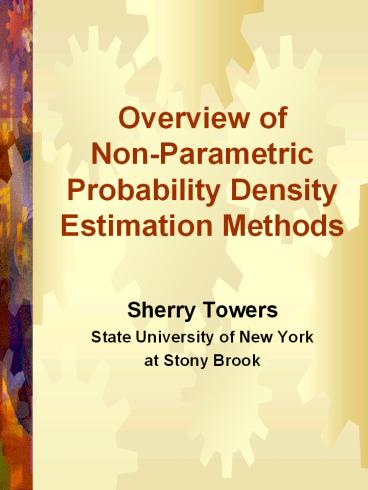Overview of Non-Parametric Probability Density Estimation Methods - PowerPoint PPT Presentation
Title:
Overview of Non-Parametric Probability Density Estimation Methods
Description:
at Stony Brook. S.Towers. All kernal PDF estimation methods (PDE's) are developed from a simple idea... If a data point lies in a region where clustering of ... – PowerPoint PPT presentation
Number of Views:105
Avg rating:3.0/5.0
Title: Overview of Non-Parametric Probability Density Estimation Methods
1
Overview of Non-Parametric Probability Density
Estimation Methods
- Sherry Towers
- State University of New York
- at Stony Brook
2
- All kernal PDF estimation methods (PDEs) are
developed from a simple idea - If a data point lies in a region where
clustering of signal MC is tight, and bkgnd MC is
loose, the point is likely to be signal
3
- To estimate a PDF, PDEs use the idea that any
continuous function can be modelled by sum of
some kernal function - Gaussian kernals are a good choice for particle
physics - So, a PDF can be estimated by sum of
multi-dimensional Gaussians centred about MC
generated points
4
5
- Best form of Gaussian kernal is a matter of
debate - Static-kernal PDE method uses a kernal with
covariance matrix obtained from entire sample - The Gaussian Expansion Method (GEM), uses an
adaptive kernal the covariance matrix used for
the Gaussian at each MC point comes from local
covariance matrix.
6
7
GEM vs Static-Kernal PDE
- GEM gives unbiased estimate of PDF, but slower to
use because local covariance must be calculated
for each MC point - Static-kernal PDE methods have smaller variance,
and are faster to use, but yield biased estimates
of the PDF
8
Comparison of GEM and static-kernal PDE
9
PDE vs Neural Networks
- Both PDEs and Neural Networks can take into
account non-linear correlations in parameter
space - Both methods are, in principle, equally powerful
- For most part they perform similarly in an
average analysis
10
PDE vs Neural Networks
- But, PDEs have far fewer parameters, and
algorithm is more intuitive in nature (easier to
understand)
11
Plus, PDE estimate of PDF can be visually
examined
12
PDEs vs Neural Nets
- There are some problems that are particularly
well suited to PDEs
13
PDEs vs Neural Nets
14
PDEs vs Neural Nets
15
PDEs vs Neural Nets
16
Summary
- PDE methods are as powerful as neural networks,
and offer an interesting alternative - Very few parameters, easy to use, easy to
understand, and yield unbinned estimate of PDF
that user can examine in the multidimensional
parameter space!































